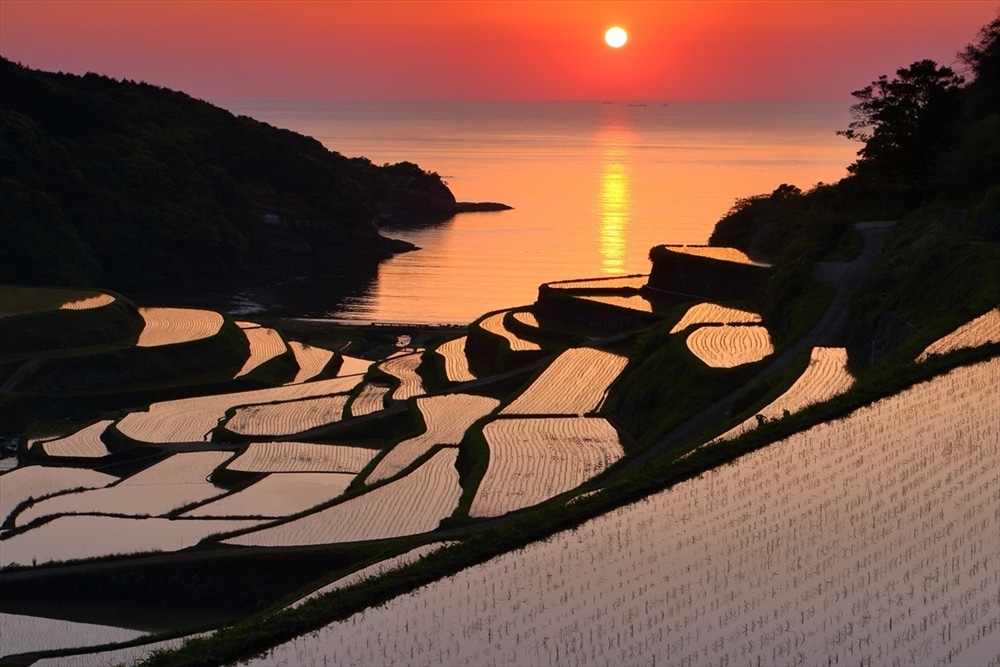
Day 1
After arriving by Shinkansen bullet train at Hakata Station, travel to the city of Saga by private vehicle. The first place on your itinerary is the Saga Castle History Museum. Visit the 2,500-square-meter reconstruction of the castle’s main keep, where the feudal lord once lived and worked. Spend time in a space steeped in history and the first such reconstruction in Japan.
From the museum, head to the Hizen Hamajuku sake brewery avenue for a stroll through a district that was the heart of sake and soy sauce production from the Edo period (1603-1867) through to the Showa era (1926-1989). The old, white-walled buildings are a picturesque reminder of the industries that once flourished here and make memorable photo backdrops. Visit an extant sake brewery to enjoy sake tasting. Be sure to try some of the sweets the brewery makes.
Your next stop is Yutoku Inari Shrine. It is considered one of Japan's three great shrines, along with Fushimi Inari Shrine in Kyoto and Kasama Inari Shrine in Ibaraki, dedicated to Inari, a popular Shinto deity. From the shrine’s main hall a walking trail leads to the shrine’s oku-no-in (inner sanctuary). Bright vermilion torii gates cover much of the path. From the oku-no-in there are magnificent views of the Ariake Sea.
Your accommodation for the night is a ryokan (traditional inn) at the hot spring town of Ureshino Onsen. The hot spring water here is recognized as one of three in Japan that is most beneficial for the skin. In an authentic Japanese-style inn surrounded by an ornate garden enjoy soothing, geothermally heated baths and relish cuisine that makes full use of seafood from the Ariake Sea and the celebrated Saga beef.
Day 2
After breakfast, leave the ryokan for a day of sightseeing.
The town of Yobuko is famous for its squid. A morning market by the harbor has been held here each day for over a century. A stroll around the market is a great way to become acquainted with Japan’s formidable “obasan” aunties, who operate many of the stalls selling the morning’s catch as well as a sundry of goods.
Leave the hustle and bustle of the market behind for the serenity of the famed Hamanoura rice terraces. Here, terraced rice paddies descend the hillsides like steps leading to the Genkai Sea. The scenery is ever changing, influenced by the vagaries of the weather and the seasons. The view is particularly spectacular between mid-April and early May, when the setting sun casts an orange glow across the surface of the sea and the freshly planted fields, which are deep in water. The geometric patterns formed by the paths between the paddies are a photographer’s dream.
Tea masters have flocked to the coastal city of Karatsu since the Azuchi-Momoyama period (1574-1600), lured by its fine Karatsu-yaki ceramics. Karatsu-yaki, which has been designated a traditional Japanese craft, is characterized by its simple, earthy style.
Return to the ryokan after lunch to relax and wander around the local area.
Day 3
Check out of the ryokan and leave for a tea plantation in Ureshino, which has been one of the top tea-producing areas since tea cultivation began in Japan some 500 years ago. At the plantation enjoy the inimitable experience of a “tea space,” any one of a number of beautifully crafted units erected within the tea fields themselves that offer views as far as the eye can see.
“Arita-yaki” is a general term used for ceramics made in the Arita area of Saga Prefecture. Production of Arita-yaki began some 400 years ago and today it is recognized as the origin of Japanese pottery making. Arita ceramics have been long sought by overseas collectors and admirers and large amounts have been exported since the Edo period. Choice pieces adorn the palaces of European royalty.
Visit a number of Arita-yaki kilns for a closer look at this much-vaunted Japanese art form before heading to Okawachiyama, a secluded village near the city of Imari. The style of pottery made here is known as “Nabeshima-yaki” as the Nabeshima clan kept tight control of the village and its kilns for some 200 years during the Edo era. Today, there are around 30 kilns that still produce authentic Nabeshima-yaki. Surrounded by mountains on three sides that evoke the steep mountain landscapes of classic ink wash paintings, the village is also known as “Hiyo no Sato” (lit. the village of secret kilns). Today it is a popular tourist destination.
When one thinks of the quintessential elements of traditional Japan, one may as well be thinking of Saga. From castles and grand shrines, to elegant ceramics, hot springs, exquisite cuisine and sake, not to mention the spectacular terraced rice fields of Hamanoura, Saga Prefecture is a picture-book image of Japan made real. Located on Kyushu, the southernmost of the archipelago’s four main islands, the prefecture is far from Tokyo. But it is well worth going the distance to discover everything that this corner of Japan has to offer.